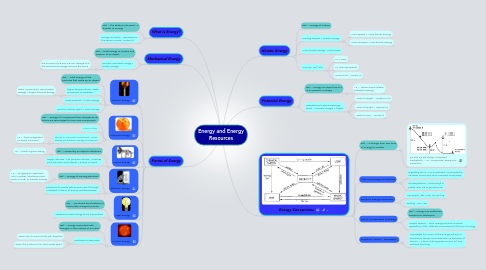
1. What is Energy?
1.1. def. -- the ability to do work-- a transfer of energy
1.2. energy and work-- expressed in the same SI units-- Joules (J)
2. Kinetic Energy
2.1. def. -- energy of motion
2.2. moving objects = kinetic energy
2.2.1. more speed = more kinetic energy
2.2.2. more massive= more kinetic energy
2.3. more kinetic energy = more work
2.4. formula: (mv^2)/2
2.4.1. m = mass
2.4.2. v= velocity (speed)
2.4.3. units of KE -- Joules (J)
3. Potential Energy
3.1. def. -- energy an object has b/c of its position or shape
3.1.1. i.e. -- rubber band (elastic potential energy)
3.2. Gravitational Potential Energy (GPE) -- formula: weight x height
3.2.1. units of weight -- Newtons (N)
3.2.2. units of height -- meters (m)
3.2.3. units of GPE -- Joules (J)
4. Mechanical Energy
4.1. def. -- total energy of motion and position of an object
4.2. formula: potential energy + kinetic energy
4.2.1. the amount of PE and KE can change, but the mechanical energy remains the same
5. Forms of Energy
5.1. Thermal Energy
5.1.1. def. -- total energy of the particles that make up an object
5.1.2. higher temperatures= faster movement of particles
5.1.2.1. faster movement= more kinetic energy = higher thermal energy
5.1.3. more particles = more energy
5.1.4. particles farther apart = more energy
5.2. Chemical Energy
5.2.1. def. -- energy of a compound that changes as its atoms are rearranged to form new compounds
5.2.2. a form of PE
5.2.3. stored in chemical compound-- when bonds are broken, energy is released
5.2.3.1. i.e. -- food is digested or wood is burned
5.3. Sound Energy
5.3.1. def. -- caused by an object's vibrations
5.3.1.1. i.e. -- pluck a guitar string
5.3.2. object vibrates ->air particles vibrate ->reaches your ear drum and vibrate = sound is heard
5.4. Electrical Energy
5.4.1. def. -- energy of moving electrons
5.4.1.1. i.e. -- plugging an appliance into a socket: electrons move back a/ forth to transfer energy
5.4.2. produced at power plants and is sent through a network of wires to homes and businesses
5.5. Light Energy
5.5.1. def. -- produced by vibrations of electrically charged particles
5.5.2. vibrations cause energy to be transmitted
5.6. Nuclear Energy
5.6.1. def. -- energy associated with changes in the nucleus of an atom
5.6.2. produced in two ways
5.6.2.1. when two or more nuclei join together
5.6.2.2. when the nucleus of an atom splits apart
6. Energy Conversions
6.1. def. -- a change from one form of energy to another
6.1.1. PE and KE are always converted back&forth -- i.e.- trampoline, swing and pendulum
6.2. Chemical Energy Conversions
6.2.1. Digesting food -- CE is released-->converted to KE when active and TE to maintain body temp.
6.2.2. Photosynthesis -- chlorophyll in plants uses NE to produce CE
6.3. Electrical Energy Conversion
6.3.1. Hair Dryer : EE-->KE, TE, and SE
6.3.2. Battery : CE-->EE
6.4. Law of Conservation of Energy
6.4.1. def. -- energy can neither be created nor destroyed
6.4.2. Closed System -- total energy remains constant regardless of the different conversions b/t forms of energy
6.5. Perpetual Motion... Impossible~
6.5.1. Impossible b/c some of the energy put into a machine is always converted into TE because of friction -- a force that opposes motion b/t two surfaces touching
